|
Janam XT1
Innovative rugged Android-based 5.9-inch mini-tablet for enterprise data capture and numerous other applications that require enough display real estate in a compact package
By Conrad H. Blickenstorfer; photography by Carol Cotton; see full PDF reprint
Janam Technologies LLC, established in 2006 and headquartered on Long Island, NY, is a provider of rugged mobile computers for barcode scanning and wireless communication. The company has deep industry knowledge and, as one of the smaller players in the handheld industry, specializes in delivering purpose-built products that may not be available elsewhere. That includes continued support of once popular legacy platforms (such as the Palm OS) as well as providing state-of-the-art and emerging technologies at an attractive price. This includes the company's XT Series of lightweight, rugged mini-tablet solutions that combine smartphone technologies with industrial-grade components and enterprise-class versatility. RuggedPCReview has had the chance examine the Janam XT1 mini-tablet, and this report we present our review and observations.
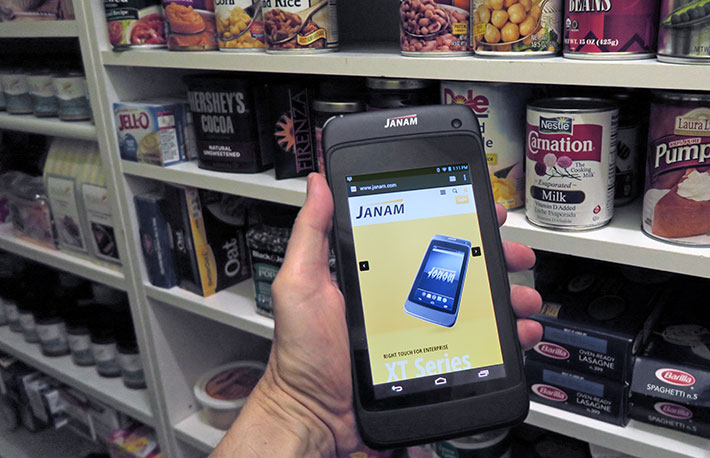
To illustrate the timeliness of the Janam XT1 as well as the company's uncanny knack of reading the past as well as anticipating the future, the XT1 was initially introduced on September 18, 2014, which happens to be the day before Apple released its big iPhone 6 Plus. The Apple phone instantly validated the big-screen form factor and went on to sell in the tens of millions. While no vertical and enterprise market product will ever reach such sales numbers, Janam correctly read the market and, with the XT1, had a product ready to bring the large-screen experience and productivity into the enterprise.
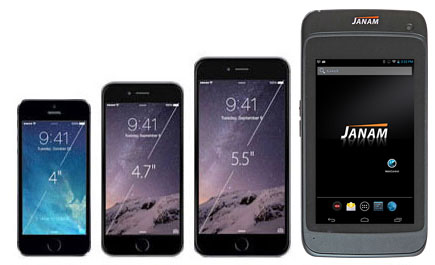 While from the vantage point of Spring 2016, the Janam XT1's size and positioning simply look right and appropriate, recall that at the introduction of Apple's big iPhone no one quite knew what to make of a handheld that clearly encroached on tablet territory, didn't easily fit into pant pockets, but was still considered a smartphone. And large though the Apple phone's screen was, the Janam XT1's 5.9-inch screen is larger yet While from the vantage point of Spring 2016, the Janam XT1's size and positioning simply look right and appropriate, recall that at the introduction of Apple's big iPhone no one quite knew what to make of a handheld that clearly encroached on tablet territory, didn't easily fit into pant pockets, but was still considered a smartphone. And large though the Apple phone's screen was, the Janam XT1's 5.9-inch screen is larger yet
The comparison picture on the right shows where the Janam XT1 fits in sizewise. Starting on the left, the Apple iPhone 4's 4-inch display was considered large when it was first introduced, certainly much larger than the 2.8 to 3.5-inch displays used for many years on phones, Pocket PCs and industrial handhelds alike.
In the middle, the iPhone 6 and 6 Plus with their 4.7 and 5.5 inch screens redefined the smartphone market. Large-screen phones had been available before, but were primarily viewed as efforts to somehow differentiate themselves from the iPhone. It was really the iPhone 6 Plus that redefined the handheld as a universal small computer that was neither just a phone nor just a tablet, but more than either.
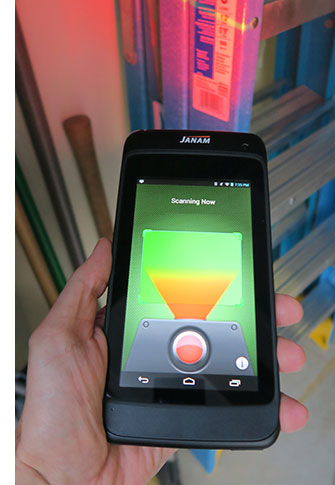 By offering a device with a slightly larger display yet — 5.9 inch — Janam correctly read that emerging trend towards big screens, but provided it in a package tough enough for enterprise and light industrial use. The device's ruggedness and extra functionality add size compared to a consumer phone and makes for a 7.8 x 3.9 inch footprint — still a bit smaller than even compact 7-inch tablets. The XT1 is half an inch thick, and weighs 13 ounces. By offering a device with a slightly larger display yet — 5.9 inch — Janam correctly read that emerging trend towards big screens, but provided it in a package tough enough for enterprise and light industrial use. The device's ruggedness and extra functionality add size compared to a consumer phone and makes for a 7.8 x 3.9 inch footprint — still a bit smaller than even compact 7-inch tablets. The XT1 is half an inch thick, and weighs 13 ounces.
This class of device doesn't have a proper name. The media initially tried the awkward term "phablet," merging the terms phone and tablet, but that never really caught on. Janam called the XT-1 a "mini-tablet" and the company's CEO, Harry Lerner, described it as follows in his initial announcement:
"Many enterprise customers require more screen viewability than traditional PDAs or handheld computers offer, yet full display rugged tablets are large, thick, heavy and unwieldy.
Janam resolves this dilemma. The XT1 blends cutting-edge technologies most often found in consumer phones with mission-critical key features that enterprises need such as ruggedness, sealing, barcode scanning and rapid battery recharging, among others. The result is a sleek, lightweight, rugged mini-tablet that delivers superior performance without sacrificing usability."
And that comes from a man who is not only an alumnus of Harvard University and the Harvard Business School, but whose resume also includes VP and General Manager positions at Symbol Technologies, the Long Island based mobile computing pioneer who later became the enterprise division of Motorola Solutions and is now part of Zebra. We're talking deep industry knowledge here.
Janam's approach with the XT1
Since the XT1 is between two types of devices — smartphones and tablets — it's interesting to see what sort of specs and technologies Janam baked into the device to meet all anticipated requirements.
 For technology, customers get a mix of consumer and industrial technology. The Janam XT1 is powered by a dual-core 1.5GHz Texas Instruments OMAP4470 processor. OMAP stands for Open Multimedia Applications Platform, and OMAP chips usually consist of a standard ARM main processor and then one or more specialized co-processors. For technology, customers get a mix of consumer and industrial technology. The Janam XT1 is powered by a dual-core 1.5GHz Texas Instruments OMAP4470 processor. OMAP stands for Open Multimedia Applications Platform, and OMAP chips usually consist of a standard ARM main processor and then one or more specialized co-processors.
The 4470, specifically, contains a PowerVR SGX544 GPU in addition to a dedicated 2D graphics core. It is the same chip used in Amazon's acclaimed Kindle Fire HD tablet as well as Xplore Technologies' RangerX, AMREL's Flexpedient AT80 tablet that we recently tested, devices from Samsung, Archos, Blackberry, and many more.
There's a gigabyte of RAM and 16GB of Flash for storage. While 16GB doesn't seem like a lot compared to iPhones which come with up to 128GB, it's perfectly adequate in devices can use expansion cards, which the XT1 can. So for the XT1 it's 16GB plus up to 64GB in its external, user-accessible micro SDHC card slot.
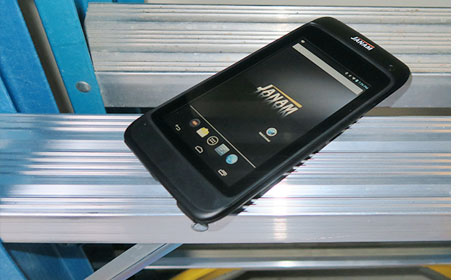 On the communications side there is dual-band 802.11a/b/g/n WiFi while many consumer devices just offer single-band WiFi. With more and more WiFi access points offering both bands, we can say from experience that being able to take advantage of whatever is fastest and most reliable in a given location is a big plus. On the communications side there is dual-band 802.11a/b/g/n WiFi while many consumer devices just offer single-band WiFi. With more and more WiFi access points offering both bands, we can say from experience that being able to take advantage of whatever is fastest and most reliable in a given location is a big plus.
Bluetooth is at the v4.0 (BLE) standard. BLE stands for Bluetooth Low Energy and refers to the fact that version 4.0 supports earlier versions of Bluetooth as well as the newer low energy protocols.
The Janam XT1 also comes with embedded NFC/RFID reading capability. Further, there's uBlox 7 Max-7 GPS with GPS/QZSS and GLONASS support, and customers can specify optional UMTS/HSDPA/HSUPA/GSM mobile broadband. The 5-megapixel autofocus camera with user-controllable LED flash would be modest in a consumer smartphone, but it's more advanced than what most industrial handhelds have.
The Janam XT1 has a user-accessible and easily removable 11.3 watt-hour Li-Ion battery. That's roughly the same capacity as the iPhone 6 Plus, so Janam's estimate of about six hours of battery life between charges sounds reasonable. Charging is either via a standard micro-USB port or via Janam's single or multi device dock.
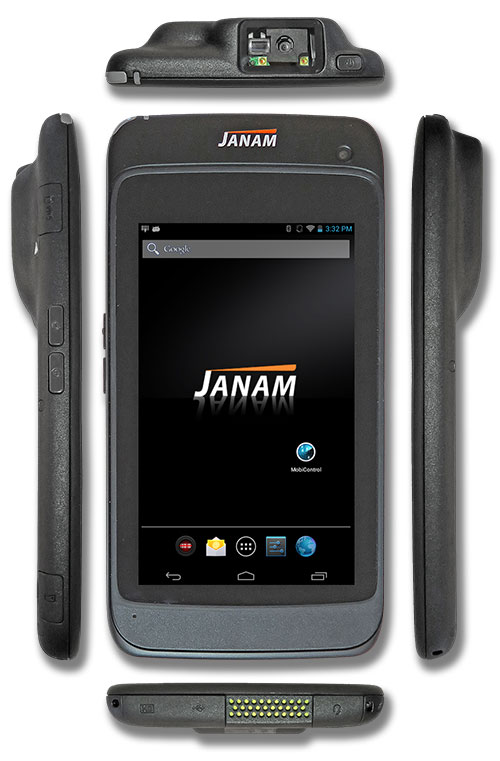 The compilation image below on the right shows the Janam XT1 from the front and from all four sides. The frontview shows the large 5.9-inch screen with its hardened glass capacitive multi-touch interface. The compilation image below on the right shows the Janam XT1 from the front and from all four sides. The frontview shows the large 5.9-inch screen with its hardened glass capacitive multi-touch interface.
The flush cover glass extends well beyond the LCD perimeter, making for smooth and easy operation. The glass is framed by a very slightly raised rubber border that serves both as a seal and to provide extra protection to the frontal glass.
On the top right is the user-facing camera lens. Unlike lenses under cover glass, this one is visible at all times, which makes it a lot easier to look into the camera during video conversations.
The top view shows the unit's 1D/2D industrial-grade bar code reader window. The "bulge" that accommodates the scanner, camera, speaker and other electronics adds about 3/8th of an inch to the main body's half inch thickness. The top also shows the power button and LED indicator lights for battery and scanner status.
The left side of the device houses the user-accessible microSD card slot, the SIM card slot, and volume up and volume down physical buttons. The two card slots have tight-fitting protective doors on flexible plastic hinges. The right side is unadorned.
The bottom of the unit shows the 32-point docking connector. It is flanked by two more protective covers. The one on the left covers an HD connector and a mini-USB port. The one on the right a headphone socket.
The XT1 doesn't have physical buttons for the standard Android controls (Back, Home, and Multitask in this version; if you remember Android having four buttons, the Menu button officially vanished with Android 4.0). Instead of hardware, the Android buttons are in software. They remain in the same spot along the small side of the LCD rectangle regardless of display orientation.
What's inside the Janam XT1?
Unlike consumer smartphones and tablets, which today are generally built as throw-away or at best recyclable items, enterprise and industrial mobile technology is expected to be easy to customize, service and repair. That's because field technology has higher costs, a longer life cycle, and is generally subjected to more wear, tear and exposure.
That's not an easy mandate for designers and manufacturers of rugged handhelds and tablets, which today are expected to look, feel and handle just like the consumer tech everyone is so familiar with. The Janam XT1 is a primary example: lay it on a table and it looks just as sleek and elegant as any piece of late model high end consumer tech.
But looks deceive as the XT1 was certainly designed for enterprise customers and duty on the job. So how is it built, and what does it look like inside?
 The XT1's housing consists of two parts that are held together by eight small Torx T5 screws. Each screw has a tiny rubber ring to provide extra sealing inside the screw hole. It's little things like this that demonstrate exceptional attention to detail. Note, of course, to make sure that all little sealer rings are accounted for and on the proper screw. The XT1's housing consists of two parts that are held together by eight small Torx T5 screws. Each screw has a tiny rubber ring to provide extra sealing inside the screw hole. It's little things like this that demonstrate exceptional attention to detail. Note, of course, to make sure that all little sealer rings are accounted for and on the proper screw.
The seal between the two halves is done by a tongue-and-groove arrangement that provides a very effective barrier against dust and liquids. A groove runs around the entire perimeter of the front part of the housing. It has a precision-cut, replaceable rubber seal inside. The bottom part of the housing has a hard plastic double lip that presses into the rubber seal.
The picture below shows the back part of the XT1 both from the outside (left) and the inside (right), as well as the battery and a peek at the scanner assembly. Note that the backside part of the housing contains almost no electronics. There's just the unit's speaker, the tiny LED flash module for the camera, the surface mount docking connector, and the WiFi/Bluetooth and NFC antennae.
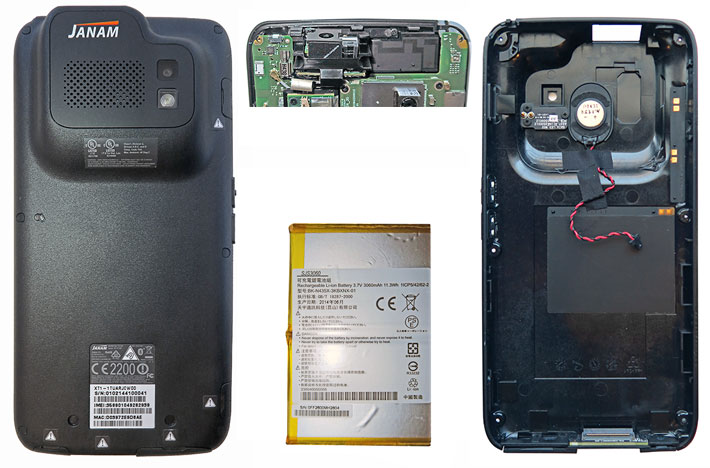
Since enterprise and industrial gear is potentially exposed to much more abuse, the selection of case material matters. To guard against damage and breakage, Janam chose PC+GF, an engineering plastic consisting of polycarbonate and glass fibers, as the XT1's housing material. Polycarbonate alone has great strength, is very resistant to heat distortion, and has self-extinguishing qualities. Add the precise right amount and type of glass fibers, and the resulting PC+GF combo offers superior tensile and flexural strength as well, optimally lending itself for very precise molding to boot (for more on PC+GF material see here).
The XT1's battery is replaceable, but not by the user. It is internally mounted and secured onto the backside of the unit's metallic LCD frame via adhesive rubber pads. The battery is a composite of two rectangular Li-Ion batteries providing a combined 3.7 Volt and 3,060 mAh for a total of 11.3 watt-hours.
As is frequently the case in rugged handheld designs, electronics consist of a motherboard for the basic functionality, and then a number of stacked daughterboards and modules for specific functionality. This allows the manufacturer or reseller to offer versions with different add-on modules for scanning, imaging, communication, etc. It also means the device can potentially be updated as newer technologies come along, an important consideration in vertical markets with their longer life cycles.
Looking at the interior of the XT1, there is plenty of shielding to meet EMI (electromagnetic interference) standards via metallic shields and enclosures. There's also tape for contact shielding and also to keep connections from rattling loose on the job. Overall, the design, layout and manufacturing of the XT1's internal electronics is logical, neat, and clean.
The image below shows what it looks like inside the Janam XT1:

For barcode reading, Janam gave the XT1 not only an industrial-grade dedicated scanner but selected a tried-and-proven module. The Honeywell N5600 is a miniature 1D/2D area imager using the mature and extensively field-tested Adaptus 6.0 Imaging Technology. It provides good motion tolerance and can handle hard-to-read codes and also those displayed on LCD screens. It reads both bar codes and OCR fonts, uses a green aiming LED, and with Standard Range optics has a read range between an inch and about a foot and 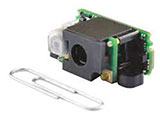 a half, depending on the symbology. For a detailed description of the N5600, see here. a half, depending on the symbology. For a detailed description of the N5600, see here.
Also note that the scanner built into the XT1 is installed at a slight downward angle. That helps when scanning an item code while still needing to view the screen. It may be a small thing, but for workers scanning a large number of items every day, it adds up to less wrist motion and less fatigue.
The image compilation below shows some of the interesting details of the Janam XT1. On the left you can see a close-up of the tongue-and-groove seal design that forms a very effective barrier against dust and liquids. Also on that picture is a close-up of the XT1's externally accessible microSD card slot. In the middle is a close-up of the unit's tiny camera module. And on the right is a side-view of the Honeywell N5600 imager that shows how it's mounted at an angle for more ergonomic use.

What's obvious here is the fundamental difference in internal design between industrial mobile gear like the Janam XT1 and consumer tech. Inside consumer tech you generally find a hyper-integrated tiny board or two. In industrial gear, everything is less integrated and more spread out to accommodate all the ports, slots, modules, and options inherent to such designs.
Large 5.9-inch display and capacitive multi-touch
The Janam XT1's 5.9-inch display makes it sort of a tweener device. 5.9 inches diagonal is bigger than what is found even on the largest smartphones (they usually max out at 5.5 inches), but smaller than on most tablets. The closest in size that we could find in the RuggedPCReview lab is an Amazon Fire HD 6 tablet. In that sense, the XT1 is a bit like Juniper Systems' Windows Embedded Handheld-based original Mesa with its 5.7-inch screen. Juniper called that device a "rugged notepad."
In terms of resolution, the XT1 offers 480 x 800 pixel WVGA, which translates into 158 pixel per inch. That's sharper than the original iPad and iPad 2, and in the neighborhood of the original iPhone and iPad Mini. It's also sharper than any non-"retina" laptop or desktop display. Few ever complained about the original iPhone and iPad resolution, and text on the XT1 is sharper than that. On the other hand, leading smartphones are now offering insanely high resolutions. The iPhone 6s Plus is at 401 ppi and the Samsung Galaxy S6 at a stunning 577 ppi. Just to give you an idea how incredibly sharp 577 ppi is, to reach that resolution, a 40-inch TV would have to have 20,480 x 11,520 pixel, almost 30 times as many pixels as the emerging 4k television standard which has 3,840 x 2,160 pixel.
All that said, while the XT1 display is sharp enough, we'd have preferred to see 1,280 x 800 pixel on this tablet, for the complete sharpness that comes in handy when reading very small text. We'd also have liked to see a display with perfect viewing angles from all directions. As is, the horizontal viewing angle is near perfect, but the vertical viewing angle is much narrower, with significant color and contrast shifts, especially from negative angles.
The picture below show a comparison between the Janam XT1 and an iPhone 6 Plus outdoors, with the XT1 set to maximum brightness and iPhone to auto-brightness. Apple's big 6 Plus is said to have a maximum screen brightness of 550-600 nits. The XT1 specs don't include a nits rating, but under most conditions, it looks almost as bright. Both displays are glossy, so there are reflections outdoors. Most smartphone and tablet users have learned to live with that.
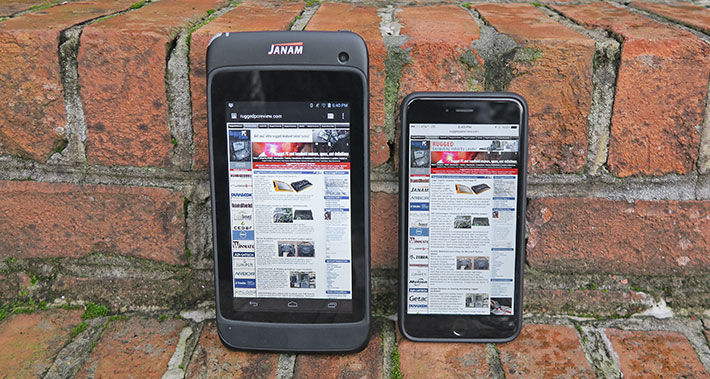
Capacitive multi-touch with its effortless tapping, panning, pinching and zooming has become the touch interface of choice on consumer smartphones and tablets. It's taken longer for the technology to be adopted in ruggedized devices designed to be used outdoors, primarily because capacitive touch doesn't work well in the rain and with gloves on. As a result, Windows-based devices, especially, stayed away from capacitive touch because, in addition to the liquid and glove issues, Windows simply wasn't designed for touch, and especially not on small screens.
Android, however, is a different story. The OS was designed from the start for use with capacitive multi-touch, and so procap is a natural for a device like the Janam XT1. In addition, Janam also gave the XT1 a touch controller that is more sensitive than that in most earlier capacitive touch devices. As a result, the XT1 can actually be operated while wearing some gloves, something that wasn't possible on the comparison iPhone 6 Plus.
Android versus Windows Embedded Handheld
The Janam XT1 runs Android 4.2.2 "Jelly Bean," a mature version of Android that as of March 2016 is used in roughly a quarter of all Android devices. Unlike Janam's XM5 and XM70 handheld computers that are offered with either Android or Windows Embedded Handheld, the XT1 is Android only. Why?
Probably because in consumer markets, the vast majority of non-Apple smartphones and small tablets run Android, and even compared to Apple, Android has a commanding overall market share on small devices. And even though Windows Embedded Handheld continues to hold on in industrial markets, Android  is now beginning to make inroads there as well. As a result, many providers of ruggedized handhelds now offer both Microsoft and Android based versions of their handhelds or are leaning towards Android. Janam's approach seems to be to offer whatever OS platform seems suited best for a certain device class and application; the company offers both Android and Windows (and yes, you can even still get Palm) in different models of its growing rugged device lineup. is now beginning to make inroads there as well. As a result, many providers of ruggedized handhelds now offer both Microsoft and Android based versions of their handhelds or are leaning towards Android. Janam's approach seems to be to offer whatever OS platform seems suited best for a certain device class and application; the company offers both Android and Windows (and yes, you can even still get Palm) in different models of its growing rugged device lineup.
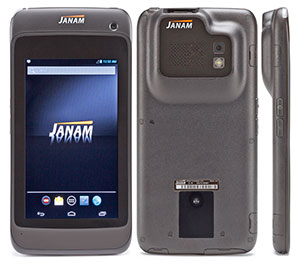 Given Android's massive market share, it's quite obvious that Android-based work devices will have instant appeal and familiarity to those who are already using Android smartphones and/or tablets at home or at work. Though often customized by voice and data service providers, the basic workings of the Android interface are very widely known by now, and a very large number of apps are available for download. Android software development and expertise is commonly available, and making Android devices available on the job can save training as well as deployment costs. Given Android's massive market share, it's quite obvious that Android-based work devices will have instant appeal and familiarity to those who are already using Android smartphones and/or tablets at home or at work. Though often customized by voice and data service providers, the basic workings of the Android interface are very widely known by now, and a very large number of apps are available for download. Android software development and expertise is commonly available, and making Android devices available on the job can save training as well as deployment costs.
One drawback of Android is its version fragmentation. While the version 4.2.2 installed on the XT1 remains supported and more than functional enough for what the XT aims to do, "Jelly Bean" has been succeeded by "KitKat" (v4.4), "Lollipop" (5.x), and "Marshmallow" (6.x), with Android "N" already being previewed. Updating Android isn't as easy as the iOS where a new version and new functionality generally are just an easy download away. In fairness, Windows Embedded Mobile/Handheld also could not easily be updated, but it's likely that Android users, spoiled by all their state-of-the-art hardware, will be more version-aware than Windows Mobile users.
Looking into the future, the question will no longer be whether to go with Android or Windows Embedded Handheld, because the latter will be replaced by the likely far more powerful Windows 10 IoT Mobile Enterprise.
Android apps: To download or not to download...
In many prior reviews of Android devices, and especially handhelds, we included a section that showed examples of some of the useful and productivity-enhancing apps that can easily be downloaded from the Google Play app store, many of them for free, and most at very reasonable costs.
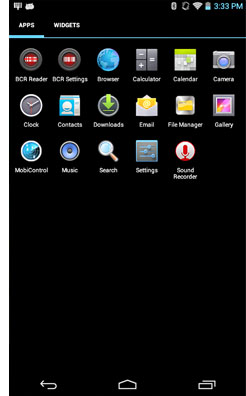 We're skipping this here for two reasons. First, there is no more need to discuss the wealth of apps available to Android-based devices. As of late 2015, there were supposedly 1.8 million apps available through the Google Play Store, surpassing even the vaunted Apple App Store. We're skipping this here for two reasons. First, there is no more need to discuss the wealth of apps available to Android-based devices. As of late 2015, there were supposedly 1.8 million apps available through the Google Play Store, surpassing even the vaunted Apple App Store.
The second reason is that our XT1 evaluation unit did not have the Google Play Store app installed. The unit came with just some basic apps installed (see screen capture to the right). Janam's manual suggests that the preferred way of installing apps is downloading them to a PC and then copying the installer to the XT1.
Adding the Google Play Store can probably be done, but the obvious fact is that a lot of businesses likely do not want their staff downloading apps into devices used for work. How is that usually handled?
One approach is to use Android AOSP, which stands for Android Open Source Project, and is an open-source software stack and project, led by Google itself, but without the ability to use the Google Play store and some of the major Google apps. Android AOSP, however, still has access to alternate app stores.
Another possibility is using something like 42Gears.com's SureLock. SureLock replaces the Android desktop and allows control of applications that are available to users. It can even be configured to run in "kiosk mode" with just a single application that is always active. This way, systems integrators or IT personnel can configure units for specific use and applications, eliminating the temptation that comes with a full load of consumer apps.
SOTI remote device management software tools are another popular solution for managing mobile enterprise devices, apps, content and security, and Janam has been making those solutions available for several years.
We just mention all this because it is one major difference between consumer devices where unlimited entertainment and information choices are a definite plus, and enterprise deployment where it is not.
Competent cameras for documentation work
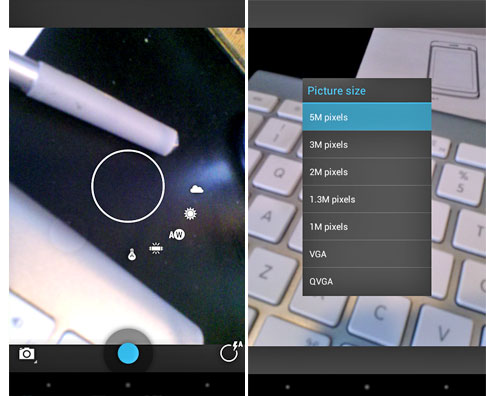 Like virtually every consumer smartphone and tablet these days, the Janam XT1 has both a front and a rear camera. The front one is primarily for video calls (though some users won't be able to resist doing the occasional selfie on the job) and offers 1.2 megapixel resolution. Like virtually every consumer smartphone and tablet these days, the Janam XT1 has both a front and a rear camera. The front one is primarily for video calls (though some users won't be able to resist doing the occasional selfie on the job) and offers 1.2 megapixel resolution.
The rear one is more for professional use, such as visually documenting job conditions, repairs, project status and such. The rear camera's maximum resolution is 5-megapixel, and it can shoot pictures with up to 2,592 x 1,944 pixel resolution. If 5-megapixel doesn't sound like a lot compared to the 8, 12 and 16-megapixel imagers found in consumer phones, consider that 2,592 x 1,944 resolution easily allows for good-looking 8.5 x 10 inch prints. Both cameras can be used for stills as well as for video.
If you're a regular reader of RuggedPCReview.com product reviews, you know that we've historically been underwhelmed by the performance of cameras integrated into rugged vertical market handhelds and tablets, with even the best ones lagging well behind what's available in dedicated point & shoots and consumer smartphones.
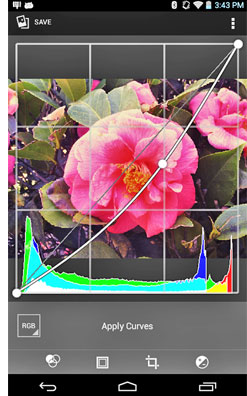 Fortunately, this is starting to change, probably because of a combination of customer demands and the availability of much better camera modules for handheld devices. In fact, the rear-facing documentation camera of the Janam XT1 is quite good. The test pictures we took with the device were good enough for most documentation tasks, something that we've been rarely been able to say about such integrated cameras. Fortunately, this is starting to change, probably because of a combination of customer demands and the availability of much better camera modules for handheld devices. In fact, the rear-facing documentation camera of the Janam XT1 is quite good. The test pictures we took with the device were good enough for most documentation tasks, something that we've been rarely been able to say about such integrated cameras.
The screen snap to the above right shows some of the camera settings screens, and what it looks like in picture-taking mode. The interface is basic but quite intuitive. Tapping the settings button on the lower right of the display brings up a circle of settings icons (camera select, flash, exposure, picture size, scene mode, and white balance). Tapping one of them brings up selections to pick from.
There isn't a wealth of settings in still image mode, with just four scene settings (auto, night, sunset and party), five white balance settings, +/-3EV exposure control, three flash modes, and picture sizes from QVGA up to 5mp. No ISO settings, HDR capturing, shutter delay, or face priority. There is, however, a panorama mode. Numerous other imaging apps are available for Android via download from various sources.
Interestingly, the on-device image editing capabilities are far more elaborate. There is a wealth of functions available, including color effects, frames, cropping, straightening, mirroring, numerous filters, and even such advanced operations as sharpening, hue, vibrance and curves (see example to the right). Here again, should more be needed — such as social media, messaging and email support — that's likely available via 3rd party apps.
In video mode, users can set video quality to 480p, 720p and 1080p, time lapse recording, white balance and LED light.
The pictures below were shot with the Janam XT1 in 5mp mode. Click on the image to bring up a full-size version.
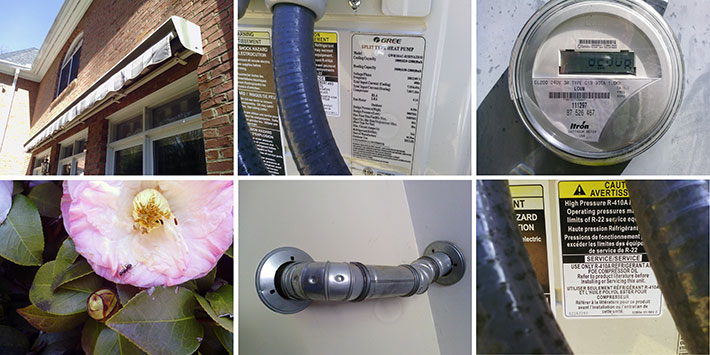
The documentation camera of the XT1 is capable of taking much better pictures than we generally see from industrial handhelds. There is good sharpness and image detail, and the focus is quick enough and quite precise. And, thankfully, there's little of the massive image compression that often renders pictures from such integrated cameras useless.
Video is also significantly better than what we've come to expect from cameras integrated into rugged devices. Frame rate and focussing are quick and the camera doesn't fall behind. The maximum 1920 x 1080 (1080p) recording format worked flawlessly. 720p and 480p formats are available as well.
The video sample clip to the right was taken with the Janam XT1 camera. It's an example of what a field service person might shoot as an attachment to a work order.
Note again that the camera applications that come with mobile operating systems are often replaced with third party applications optimized for certain tasks, or developers and systems integrators include camera and video functionality directly into custom applications.
Overall, the still image and video functions of the Janam XT1 are better than average and definitely good enough for most documentation jobs.
Accessories
As is usually the case with devices geared towards enterprise and industrial markets, Janam offers a variety of accessories specifically designed to protect the XT1 and make it as easy to use and carry around as possible.

That includes an operating case with a swivel strap (left in image above), a nylon belt holster (middle in image above), and an operating strap (right in image above). In addition, Janam also a single unit Ethernet/USB charging cradle, and a six-slot Ethernet/USB cradle kit for multiple unit deployments.
Enterprise-grade toughness and durability
Ruggedness is yet another difficult area for the makers of contemporary ruggedized mobile computing devices. It's not easy to create a handheld or tablet that looks as sleek and elegant as a consumer device, but is much tougher. And with an increasing number of smartphones now fully sealed to IP67 specifications, it's actually hard for rugged devices, which are heavier and have more openings due to their more comprehensive connectivity, to even keep pace in some ruggedness areas.
How did Janam handle this challenge with the undeniably elegant XT1? Our detailed examination of its structural and interior design already revealed that the XT1 is very well built. But how is that reflected in its specifications?
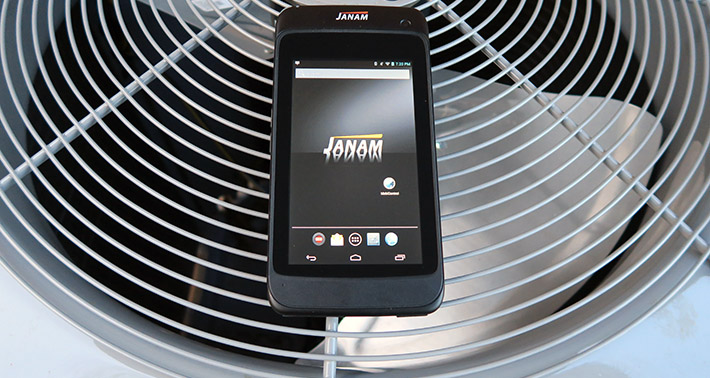
First, the Janam XT1 carries IP54 sealing where the "5" means it's protected against dust, but with limited, non-harmful, ingress permitted, and the "4" that it is also protected against water spray from all directions, again with limited ingress permitted. That makes the XT1 suitable for use in the field, in dusty environments, and also in rain, but don't drop it into a puddle or stream, or use it in a sandstorm. From the looks of it, an IP65 rating (which would mean fully dust-proof and able to handle low-pressure water jets) might only require slightly redesigned protective port plugs. It should be worth it for Janam to look into that.
The device can handle multiple drops from three feet to concrete. Such a drop could easily damage or even destroy a consumer tablet or startphone, but we'd rather see a four-foot drop spec. That's because when you drop a handheld device while operating it in a standing position, it'll fall about four feet. Small rubber bumpers on the four corners would probably yield protection from four feet or more, but they'd mar the sleek and elegant design. Note that Janam's optional leatherette operating case might provide the additional extra bit of drop protection.
The stated operating temperature range of 14 to 122 degrees Fahrenheit (-10 to 50 degrees Celsius) is wide enough to allow the device to be used almost anywhere.
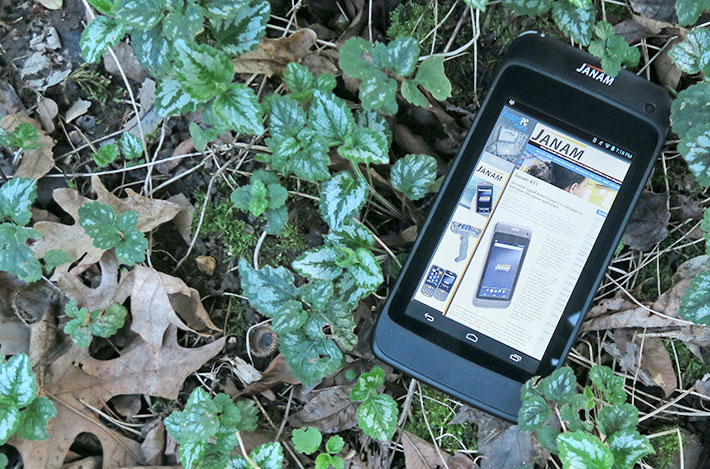
Janam specs also state vibration testing at 2.13 Grms from 5Hz to 200Hz in all three axes, 20 minutes per axis, but there's no reference to which tests were performed (in general, MIL-STD-810G, Method 514.5 is used for vibration testing). It'd be good to know specifics.
Since many XT1 tablets will be used in clinical or food service applications, the specs mention sterilization with a 75% concentration alcohol rub.
Overall, our impression is that Janam designed the XT1 to be resistant to the types of environmental challenges it'll likely encounter on jobs it's intended for, rather than increasing size, weight and cost to guard against perils outside its expected deployments. Makes perfect sense.
Summary: Janam XT1 — well-executed Android mini-tablet for enterprise applications
What customers get with the Janam XT1 "mini-tablet" is a light and handy data collection and communication device with a larger screen than virtually any other handheld computer. Yet, it comes in a package that's smaller than even compact tablets, one that allows enterprise and government customers to use (and explore, if they haven't already) Android, the OS that dominates the smartphone market worldwide.

The Janam XT1 is a device that adheres to the needs of enterprise customers, which are different from those of consumers. That means, for example, the use of enterprise-grade components such as an integrated Honeywell 1D/2D barcode reader module rather than just using the internal camera with a scanner app as consumer devices usually do.
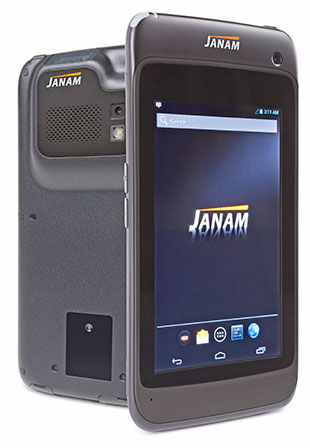 The bright 5.9-inch capacitive multi-touch display of the Janam XT1 offers more screen real estate than even the largest smartphones. Yet, the device is handier and more compact than any tablet, and most people can easily hold it in one hand. At 13 ounces it's still light enough to be held and carried around for extended periods of time. The internal, non user-replaceable battery lasts about six hours, depending on the type of use. The bright 5.9-inch capacitive multi-touch display of the Janam XT1 offers more screen real estate than even the largest smartphones. Yet, the device is handier and more compact than any tablet, and most people can easily hold it in one hand. At 13 ounces it's still light enough to be held and carried around for extended periods of time. The internal, non user-replaceable battery lasts about six hours, depending on the type of use.
There's integrated GPS, NFC/RFID reading, and optional mobile broadband. There's an integrated industrial-grade 1D/2D imager for bar code reading. The dual cameras (5mp and 1.2mp) work fine and are easy to use.
The device is well designed, attractive and meticulously finished. Ruggedness is enterprise-grade, i.e. durable and capable for tasks in the field, but not fully rugged or fully sealed.
In summary, with the Android-powered XT1, Janam offers an interesting, elegant and very durable handheld computer for enterprise and government markets that in terms of size is somewhere between smartphone and tablet.
Its intended applications include data collection, communication, field service, logistics, positioning and anything else that benefits from a device that doesn't mind use in the field, has a large enough display for demanding applications, yet is still small enough to fit almost anywhere.
-- Conrad H. Blickenstorfer, March 2016
Janam XT1 Specs:
| Added/changed |
Added 09/2014, updated 12/2015, full review 03/2016
|
| Type |
Rugged Android tablet
|
| Processor |
1.50GHz Texas Instruments OMAP4470
|
| Graphics |
PowerVR Series5XT GPU
|
| OS |
Android 4.2.2
|
| Standard/Max RAM |
1GB RAM |
| Disk/drive |
16GB ROM onboard, plus microSD card storage (up to 64GB) |
| Display type |
TFT LCD with hardened glass |
| Display size/resolution |
5.9" WVGA (800 x 480 pixel) |
| Digitizer |
Projected capacitive multi-touch |
| Keyboard/keys |
Onscreen
|
| Navigation |
Touch
|
| Expansion slots |
1 x microSDHC Card, 1 X SIM
|
| Housing |
PC+GF polycarbonate
|
| Size |
7.8 x 3.9 x 0.5 inches (201 x 99 x 15 mm)
|
| Weight |
13 oz (370g) incl. battery
|
| Operating temperature |
-10° to 50°F (14° to 122°F) |
| Ingress protection |
IP54 (protected against dust and water spray from all directions) |
| Humidity |
95% non-condensing |
| Drop |
Multiple 3-foot drops on all sides |
| Vibration |
2.13 Grms from 5 to 200Hz in all three axes, 20 min/axis |
| EMI |
FCC Part 15B; EN55022; EN55024; EN61000-3-2; EN61000-3-3 |
| Tumble |
Unknown |
| RF |
FCC Part 15B and 15C; EN301 489-1; EN301 489-3; EN 301 489-7; EN301 489-17; EN 301 489-24; EN300 328; EN301 893; EN300 440; EN301 908-1; EN301 908-2; EN301 511; EN302 291-1; EN302 291-2; EN50566; EN62209-2; EN62479; EN50332 |
| Intrinsic safety |
Class I Div 2, Groups A, B, C, D certification |
| Power |
Non user-replaceable 3.7V 3,060mAh 11.3 watt-hour rechargeable Li-Ion battery ("6 hours") |
| Scanner |
Honeywell N5600 with 2D Adaptus Imaging Technology; 844 x 640 pixel CMOS area imager |
| Camera |
1.2mp front-facing; 5.0mp rear-facing auto-focus with user-controllable LED flash |
| GPS |
uBlox 7 MAX 7 and A-GPS |
| Sensors |
G-sensor, accelerometer |
| Wireless |
802.11 a/b/g/n WiFi, Bluetooth v4.0 (BLE), UMTS/HSDPA/HSUPA/GSM, uBlox GPS and A-GPS |
| Interface |
2 x micro USB, 3.5mm audio in/out |
| Price |
Seen at US$900 to US$1,300, depending on options |
| Spec sheet |
 Janam XT1 brochure (PDF) Janam XT1 brochure (PDF)
|
| Web page |
Janam XT1 web page |
| Contact |
Janam
100 Crossways Park West
Woodbury, NY 11797
1-877-JANAM-99
www.janam.com
|
|






